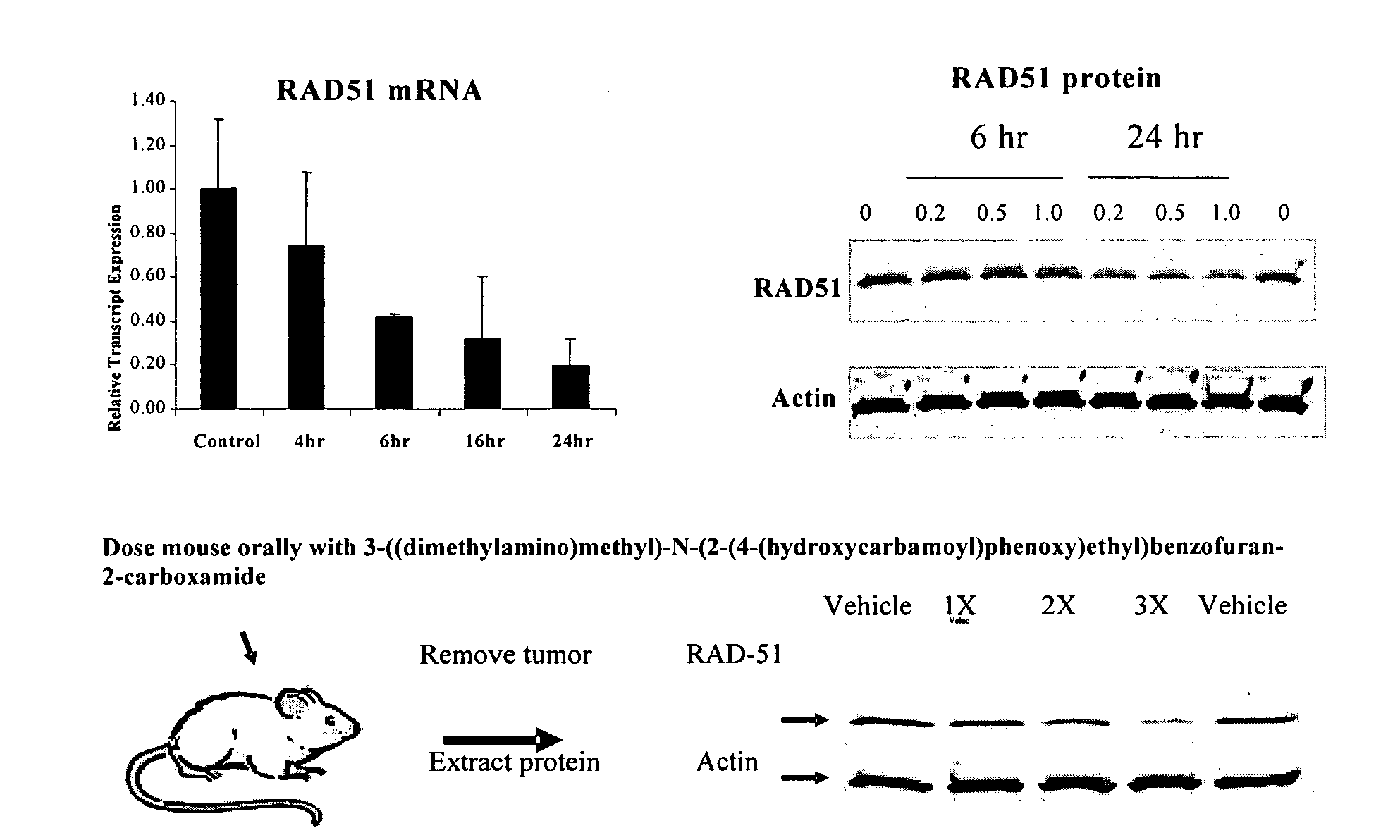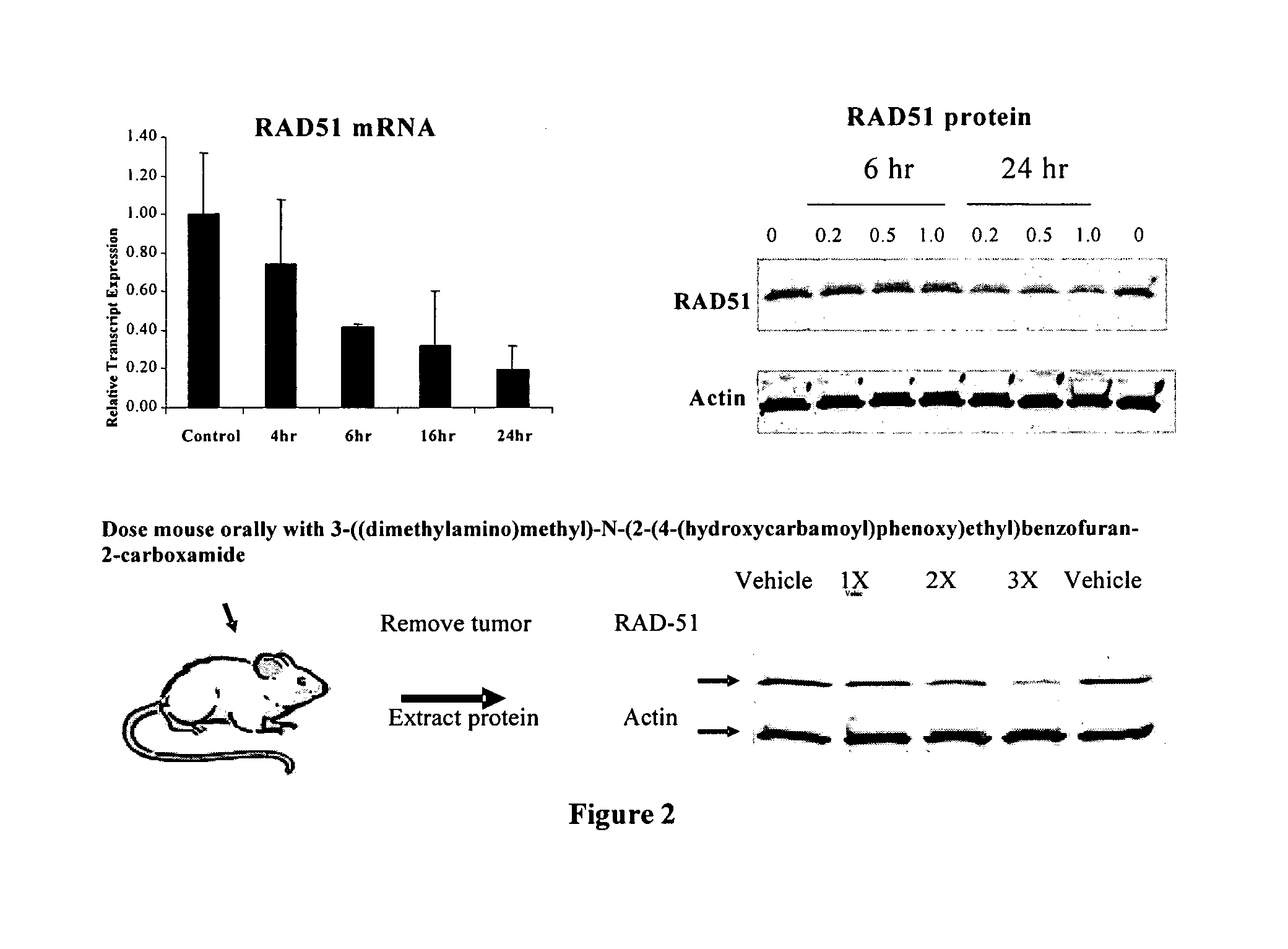Method of using histone deacetylase inhibitors and monitoring biomarkers in combination therapy
a technology of histone deacetylase and combination therapy, which is applied in the direction of biocide, heterocyclic compound active ingredients, drug compositions, etc., can solve the problems of severe cell dysfunction, oncogensis, cell death, etc., and achieve the effect of reducing the cellular level of rad51 and inhibiting the activity
- Summary
- Abstract
- Description
- Claims
- Application Information
AI Technical Summary
Benefits of technology
Problems solved by technology
Method used
Image
Examples
example 1
Inhibition of HDAC
[0372]Measurements are performed in a reaction volume of 100 μL using 96-well assay plates. HDAC-1 (200 μM final concentration) in reaction buffer (50 mM HEPES, 100 mM KCl, 0.001% Tween-20, 5% DMSO, pH 7.4) is mixed with inhibitor at various concentrations and allowed to incubate for 30 minutes, after which trypsin and acetyl-Gly-Ala-(N-acetyl-Lys)-AMC are added to final concentrations of 50 nM and 25 μM, respectively, to initiate the reaction. Negative control reactions are performed in the absence of inhibitor in replicates of eight.
[0373]The reactions are monitored in a fluorescence plate reader. After a 30 minute lag time, the fluorescence is measured over a 30 minute time frame using an excitation wavelength of 355 nm and a detection wavelength of 460 nm. The increase in fluorescence with time is used as the measure of the reaction rate. Inhibition constants are obtained using the program BatchKi (Kuzmic et al., 2000, Anal. Biochem. 286: 45-50).
[0374]Studies h...
example 2
Inhibition of HDAC in Cell Extracts
[0375]HeLa nuclear extracts (supplier: Biomol) are incubated at 60 μg / ml with 2×10−8 M of radiolabeled peptide substrate. As a substrate for measuring HDAC activity a synthetic peptide, i.e. the amino acids 14-21 of histone H4, is used. The substrate is biotinylated at the NH2-terminal part with a 6-aminohexanoic acid spacer, and is protected at the COOH-terminal part by an amide group and specifically [3H]acetylated at lysine 16. The substrate, biotin-(6-aminohexanoic)-Gly-Ala-([.sup.3H]-acetyl-Lys-Arg-His-Arg-Lys-Val-NH.sub.2), is added in a buffer containing 25 mM Hepes, 1 M sucrose, 0.1 mg / ml BSA and 0.01% Triton X-100 at pH 7.4. After 30 min the deacetylation reaction is terminated by the addition of HCl and acetic acid. (final concentration 0.035 mM and 3.8 mM respectively). After stopping the reaction, the free 3H-acetate is extracted with ethylacetate. After mixing and centrifugation, the radioactivity in an aliquot of the upper (organic) p...
example 3
Cell Proliferation Assay In Vitro
[0377]The ability of the compounds of Formula (A) or Formula (I) to inhibit growth of tumor cells in vitro is determined as follows.
[0378]Stock cultures of the HCT116 colon carcinoma and other cell lines are maintained in RPMI medium 1640 containing 10% (v / v) fetal bovine serum, 2 mM L-glutamine, 1 mM sodium pyruvate, 50 units / ml penicillin, and 50 μg / ml streptomycin at 37° C. in 5% CO2 humidified atmosphere. Cells are cultured in 75-cm2 culture flasks and subcultures are established every 3 to 4 days so as not to allow the cells to exceed 90% confluence.
[0379]HCT116 clls are harvested for proliferation assays by trypsinization (0.05% trypsin / 0.53 mM EDTA), washed twice in culture medium, re-suspended in appropriate volume of medium, and then counted using a hemacytometer. Cells are seeded in wells of flat-bottom 96-well plates at a density of 5,000 cell / well in 100 μl. Cells are allowed to attach for 1.5 to 2 hours at 37 C.
[0380]Compounds are dilute...
PUM
| Property | Measurement | Unit |
|---|---|---|
| concentrations | aaaaa | aaaaa |
| concentrations | aaaaa | aaaaa |
| concentrations | aaaaa | aaaaa |
Abstract
Description
Claims
Application Information
 Login to View More
Login to View More - R&D
- Intellectual Property
- Life Sciences
- Materials
- Tech Scout
- Unparalleled Data Quality
- Higher Quality Content
- 60% Fewer Hallucinations
Browse by: Latest US Patents, China's latest patents, Technical Efficacy Thesaurus, Application Domain, Technology Topic, Popular Technical Reports.
© 2025 PatSnap. All rights reserved.Legal|Privacy policy|Modern Slavery Act Transparency Statement|Sitemap|About US| Contact US: help@patsnap.com



